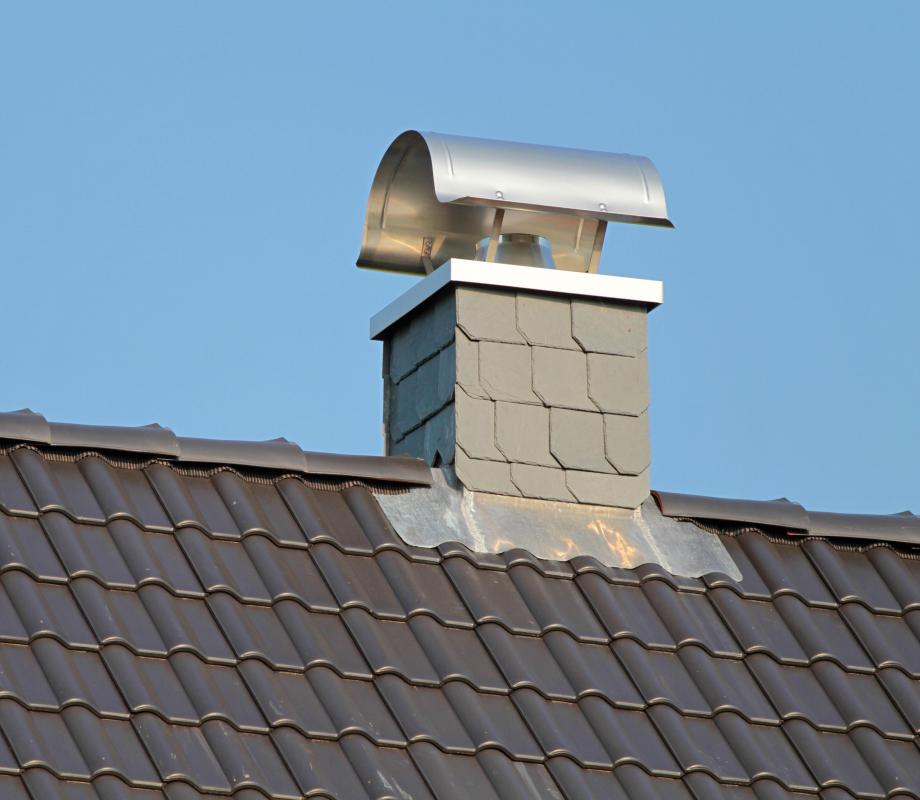At WiseGEEK, we're committed to delivering accurate, trustworthy information. Our expert-authored content is rigorously fact-checked and sourced from credible authorities. Discover how we uphold the highest standards in providing you with reliable knowledge.
What Causes a Chimney Leak?
One of the main causes of a chimney leak is deflective flashing. Problems with flashing can be due to wear and tear, corrosion, or improper installation. Flashing problems are usually verified by using a low pressure hose to spray water from around the chimney to the roof intersection. The presence of water indicates that repairs will be needed.
Ensuring that flashing is constructed of good material that is resistant to leakage is a way to protect leaks from occurring. Lead is the best material for flashing, but lead-coated copper and plain copper can help to deter leaks as well. Though inexpensive, aluminum has a high-corrosion rate and shouldn't be used for flashing. In addition, flashing should be properly installed in "step" fashion using 1 inch (2.54 cm) slots. Home owners should avoid the trend of gluing flashing on the brick because of this method's propensity for encouraging leaks.

Another problem that may lead to a chimney leak involves the top of the chimney itself. If the top of a chimney is cracked or loose, the abnormality may result in leaks, and gallons of water may accumulate inside of the chimney. During installation of the chimney, this can be avoided by requiring that bricklayers completely fill a chimney's interior with brick and mortar to avoid the formation cracks and crevices. When constructing the top 5 feet (1.52 m) of a chimney, brick masons can also be instructed to use nonporous hydraulic cement for mortar. If a home owner is experiencing a chimney leak with a chimney that has already been installed, he may consider installing a lead-coated copper sheet cover over the chimney to prevent water from falling into the chimney.

Crickets, or small, roof-like apparatuses, can also be installed into the chimney. Crickets divert the flow of water so that the chimney's structure and its flashing are not negatively impacted by the water's presence. While crickets can be installed at any time, home owners may be able to save money by having them installed while the chimney is being constructed.

A chimney that has wood or cedar siding can contribute to a chimney leak. Knots in these types of wood can become loose or will simply dislodge, opening up an area where water can cause a leak. If these materials split, a chimney leak can present itself and it may only be discovered after concentrated inspection of the underside of the chimney's siding.
AS FEATURED ON:
AS FEATURED ON:














Discussion Comments
Whenever I get leaks around my chimney I go on the roof with a container of tar and look for openings. This is all it takes to stop most of these leaks. It isn't very complicated to get all of the openings filled in. You can also buy sealant in a spray can, and this works, too.
@Feryll - With chimney leaks, the water uses this area around the chimney to get beneath the shingles onto the top of the house. Once the water breaks through this shingle barrier it runs along the actual wood structure of the roof and finds a hole or crevice where it can enter into your attic space. If there is no opening then the water will just saturate an area and then begin to drip into your house.
It's not uncommon for leaks to be some distance from the openings where the water is seeping through your roof shingles. An experienced roofer knows what to look for.
Before we purchased our house we could see that there had been leaks coming through the ceiling in a few of the rooms. No one had lived in the house for a couple of years, and it was a foreclosure, so we didn't know whether the places in the roof had been repaired or whether they were still letting water enter the house.
After we bought the house and we got a big rain storm we saw that there were places where the roof still leaked, but we couldn't find the exact spots where the water was entering. We decided to call a roofer to take a look and find the leaks.
He was only on the roof for about 20 minutes and then he came down and said we were all set. As it turned out, most of the flashing around the chimneys had been loose. It was strange that when I would go into the attic and look for the leaks the water did not appear to be entering the attic around the chimneys, but that is where the water was entering initially.
Once the roofer repaired the flashing, most of the leaks stopped. According to him, loose flashing is usually the cause of leaks on the houses he repairs.
Post your comments